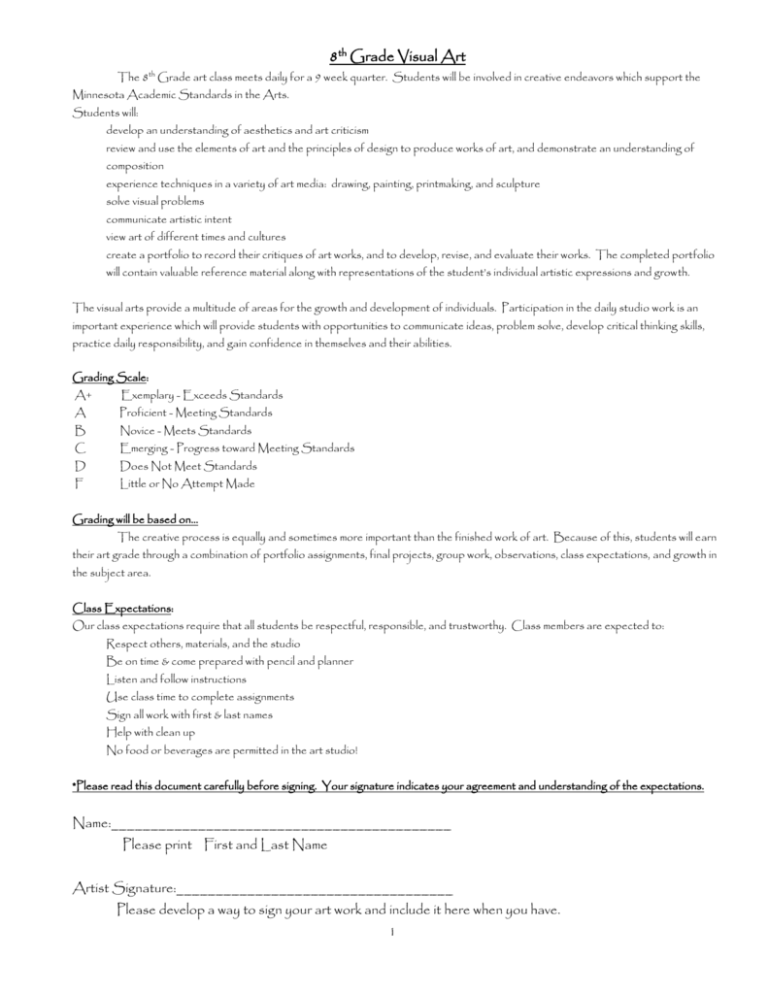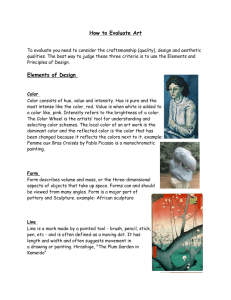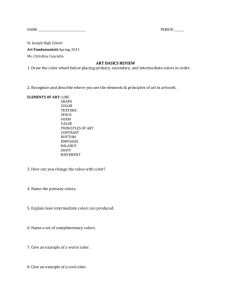8th Grade Visual Art The 8th Grade art class meets daily for a 9
advertisement

8th Grade Visual Art The 8th Grade art class meets daily for a 9 week quarter. Students will be involved in creative endeavors which support the Minnesota Academic Standards in the Arts. Students will: develop an understanding of aesthetics and art criticism review and use the elements of art and the principles of design to produce works of art, and demonstrate an understanding of composition experience techniques in a variety of art media: drawing, painting, printmaking, and sculpture solve visual problems communicate artistic intent view art of different times and cultures create a portfolio to record their critiques of art works, and to develop, revise, and evaluate their works. The completed portfolio will contain valuable reference material along with representations of the student’s individual artistic expressions and growth. The visual arts provide a multitude of areas for the growth and development of individuals. Participation in the daily studio work is an important experience which will provide students with opportunities to communicate ideas, problem solve, develop critical thinking skills, practice daily responsibility, and gain confidence in themselves and their abilities. Grading Scale: A+ Exemplary - Exceeds Standards A Proficient - Meeting Standards B Novice - Meets Standards C Emerging - Progress toward Meeting Standards D Does Not Meet Standards F Little or No Attempt Made Grading will be based on... The creative process is equally and sometimes more important than the finished work of art. Because of this, students will earn their art grade through a combination of portfolio assignments, final projects, group work, observations, class expectations, and growth in the subject area. Class Expectations: Our class expectations require that all students be respectful, responsible, and trustworthy. Class members are expected to: Respect others, materials, and the studio Be on time & come prepared with pencil and planner Listen and follow instructions Use class time to complete assignments Sign all work with first & last names Help with clean up No food or beverages are permitted in the art studio! *Please read this document carefully before signing. Your signature indicates your agreement and understanding of the expectations. Name:___________________________________________ Please print First and Last Name Artist Signature:___________________________________ Please develop a way to sign your art work and include it here when you have. 1 Elements of Art and Principles of Design Elements of Art are the building blocks of creation, the parts that are put together to make a work of art. They are the artists’ tools. Line – a path made by a moving point. Line can show direction, define shapes as well as create texture and value. Lines are vertical, horizontal, diagonal, curved, or zigzag. Shape – is two dimensional (height and width) and encloses space. Form – is three dimensional (height, width, and depth) and encloses space. Shapes/Forms can be either geometric or organic (free-form): Geometric: mathematical shapes Organic/Free-form: shapes found in nature or made up Space – the empty area between, around, above, below, or within objects. Positive space is the area occupied by shape or form. Negative space is the area surrounding shapes or forms. Texture – refers to how things feel or appear to feel. Actual texture is the way something feels. Simulated/Visual texture is the way something appears to feel. Value – darkness or lightness (amount of light a surface reflects) Color – the eye’s response to different wavelengths of light – reflected light. The three properties of color are hue, value, and intensity. Principles of Design are the way the elements of art are put together to make a work of art. They are the artists’ rules. Pattern – repetition of an element of art as a decorative design. Rhythm – repetition of elements to create the illusion of movement or feeling of action. Random, regular, alternating, flowing, and progressive Balance – arranging visual elements in a work of art equally, or to give the work a feeling of being equal by weight, interest or contrast. Formal or Symmetrical balance: both halves are equal/same Informal or Asymmetrical balance: both halves are different but the work of art still seems even. Radial balance: all elements of a composition converge from a central point. Movement – creating the illusion of action or physical change in position or how the viewer’s eye is directed through a work. Contrast – create dramatic change in elements. Variety: to alter elements in a work Emphasis – stresses one element or focal point to make it attract the viewers’ attention first. Unity - allows the viewer to see a combination of the elements, principles, and media as a whole. The elements work together which is our goal! *Proportion – size relationships of one part of an object to the whole object (and/or one part to another part). * Scale – size relationship of one object to another object. 2 Proportion & Scale (technically these are not principles of design, but are important in art works) Proportion and scale can be very dominant in art works. Both deal with size and both can be realistic or exaggerated. Proportion deals with only one object, for example a face. In figuring out whether it is realistic or exaggerated proportion, comparison happens between one part of the object (an eye) to the whole object (the face). If proportions are realistic, the image looks right. If proportions are exaggerated, the image will appear distorted. Scale compares one object to another object. Think about comparing a model car to an actual car. The scale is exaggerated smaller in the toy car (although the proportions of the model could be identical to that of the actual car). What principle is being emphasized in the drawing?_______________ Is it a realistic or exaggerated example of the principle you named? Explain your answer. _____________________________________________ _____________________________________________ _____________________________________________ _____________________________________________ _____________________________________________ _____________________________________________ _____________________________________________ _____________________________________________ This diagram shows approximate proportions of the average, _____________________________________________ adult, human man. Using the head as the unit of ___________ measurement- approximately 7 ½ head lengths stacked equal the height of the human body. Each person’s head should be proportionate to their body in this way. Choose a classmate to test it out! Explain what you found. _____________________________________________ _____________________________________________ _____________________________________________ _____________________________________________ _____________________________________________ _____________________________________________ _____________________________________________ _____________________________________________ _____________________________________________ _____________________________________________ _____________________________________________ _____________________________________________ 3 _____________________________________________ _____________________________________________ _____________________________________________ Art Styles and Movements Realism: a type of art that shows things exactly as they appear in life. Artists: Close, Rembrandt, Whistler Abstract: Twentieth-century art containing shapes that simplify real objects to emphasize form instead of subject matter. You may not recognize specific objects. Artists: O’Keefe, Matisse, Chagall Non-objective: Art that has no recognizable subject matter. Artists: Mondrian, Calder, Pollock, Rothko Expressionism: Twentieth-century art movement. A style that emphasizes the expression of ones feelings. Artists: VanGogh, Kollwitz Impressionism: Style of painting starting in France in the 1860s. It featured everyday subjects and emphasized the momentary effects of light on color. Impressionist paintings include relatively small, thin, yet visible brush strokes; Artists: Monet, Hiroshige, Degas, Cassatt Surrealism: Prefix: sur-beyond, Root Word: real-fact, Suffix: ism-school of thought. Twentieth-century art movement that tried to represent the subconscious mind by creating fantastic imagery and juxtaposing ideas that seem to contradict each other. Artists: Bacon, Dali, Chagall, Miro, Magritte Fauvism: French for "wild beasts". It got this name because the paintings had bright and unusual colors. The subjects in the paintings were shown in a simple way, and the colors and patterns were bright and wild. Artists: Matisse, Marc Cubism: Twentieth-century art movement that emphasizes structure and design. Three-dimensional objects are pictured from many different points of view at the same time. Cubism was the beginning of the Abstract and Non-objective art styles. Artists: Picasso, Braque, Duchamp Pop art : Artistic style used in the early 1960s in the United States that portrayed images of popular culture (mass media, commercial art, comic strips, advertising). Artists: Warhol, Lichtenstein, Oldenburg, Thiebaud Op art: Optical art. A twentieth-century artistic style in which artists use scientific knowledge about vision to create illusions of movement. Artists: Riley, Agam, Escher Common Techniques (same word used to describe techniques in multiple mediums): Medium is the art materials used in a specific art work, ie. oil on canvas, watercolor, graphite, colored pencil. Blend ________________________________________________________________________ Burnish _______________________________________________________________________ Cross-hatching__________________________________________________________________ Frottage_______________________________________________________________________ Glaze_________________________________________________________________________ Hatching______________________________________________________________________ Implied________________________________________________________________________ Masking_______________________________________________________________________ Relief_________________________________________________________________________ Scoring_______________________________________________________________________ Sgrafitto______________________________________________________________________ Shade________________________________________________________________________ Stipple________________________________________________________________________ Wash_________________________________________________________________________ 4 Basic Facial Features Left eye Right eye Nose 1 2 3 4 5 Mouth Eye widths Crown of Head The eyes are ½ way between the crown of the head and the chin. The bottom of the nose is ½ The ears are way between the eyes and between the middle the chin. of the eyes and the bottom of the nose. The middle of the mouth is ½ between the bottom of the nose and the chin. 5 Chin Grid Drawing Another way artists use scale and proportion is through grid drawings. If attempting to achieve correct proportions in a larger or smaller format, the artist would create a grid over the image and again on a blank picture plane. Then the artist enlarges or decreases the size accordingly box by box. Try it below. Include values as they have been used in the original. 6 Art Criticism Title: ________________________________ Artist: _______________________________ Date: ________________________________ Size: _________________________________ Medium: _______________________________ Describe what you see (Fact; what is literally in the image) : __________________________________________________________________________________ __________________________________________________________________________________ __________________________________________________________________________________ __________________________________________________________________________________ __________________________________________________________________________________ __________________________________________________________________________________ __________________________________________________________________________________ __________________________________________________________________________________ Analyze how this work is organized (Elements and Principles): __________________________________________________________________________________ __________________________________________________________________________________ __________________________________________________________________________________ __________________________________________________________________________________ __________________________________________________________________________________ __________________________________________________________________________________ __________________________________________________________________________________ Interpret what the artist is trying to communicate: __________________________________________________________________________________ __________________________________________________________________________________ __________________________________________________________________________________ __________________________________________________________________________________ __________________________________________________________________________________ __________________________________________________________________________________ __________________________________________________________________________________ __________________________________________________________________________________ Judge what you think of the artwork: __________________________________________________________________________________ __________________________________________________________________________________ __________________________________________________________________________________ __________________________________________________________________________________ __________________________________________________________________________________ 7 Art Element Color / ColorTheory The properties of color are: Hue: color name, pure color found on the color wheel Value: lightness and darkness A tint is a hue plus white. A shade is a hue plus black. Intensity: brightness or dullness- (bright red, pale blue, etc…) Primary colors are the hues from which all other colors are made. They cannot be made. The primary colors are yellow, red and blue. Secondary colors are made by mixing two primary hues. The secondary colors are orange, violet and green. Tertiary or Intermediate colors are made by mixing a primary and a secondary hue. Tertiary colors are yellow-orange, yellow-green, blue-violet, blue-green, red-violet, and red-orange. Color Schemes: specific arrangements of colors Warm: red, orange, and yellow (these colors tend to come forward in a work of art) Cool: blue, green, and violet (these colors tend to recede in a work of art) Monochromatic: one color and its tints and shades Complementary: colors opposite each other on the color wheel Neutral: black, white, gray as well as browns which are made by mixing complements Achromatic: black, white and grays (no color/hue) Analogous: 3 to 5 colors which are right next to each other on the color wheel Triad: three colors that form an equilateral triangle on the color wheel. YO O Y YO YG YO G BG RO B R RV BV V 8







